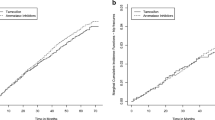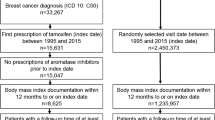Abstract
No study has yet analyzed the impact of compliance with aromatase inhibitor(AI) treatments on fracture risk in a real-world setting in women with breast cancer. In this study, 8732 women with BC treated with AI, 8732 treated with tamoxifen (TAM), and 8732 age-matched women without BC selected from the Disease Analyzer database (IMS Health) were included. The main outcome measure was the impact of compliance with AI treatment on fracture risk. Demographic data included age, body mass index (BMI), and smoking status. Alcohol dependency, dementia, bone density, visual disturbances, diabetes, and use of corticosteroids were also assessed. Kaplan–Meier curves were used to analyze the proportion of patients with fracture over time, and multivariate Cox regression models were performed to assess the adjusted fracture risk. Mean age was 67.3 years. 17.6, 8.7, and 8.8 % of AI, TAM, and non-cancer patients, respectively, were diagnosed with fracture within 5 years after the index date (p < 0.001). The proportion of women receiving AI with fracture increased with treatment compliance, rising from 8.6 % when treatment persisted for less than a year to 18.0 % when it persisted for between 4 and 5 years (p < 0.001). By contrast, the proportion of fractures in women with BC receiving TAM for the same time periods decreased from 13.0 to 7.9 % (p < 0.001). The risk of fracture was higher in women with BC using AI than in the non-cancer group (HR = 3.00; p < 0.0001). Finally, current smoking status, BMI, dementia, and prescription of corticosteroids had significant impacts on fracture risk. Compliance with AI treatment in women with BC is associated with a clear increase in the risk of fracture, which is much higher than previously reported.




Similar content being viewed by others
References
World Cancer Research Fund International: Worldwide data. http://www.wcrf.org, 2015, Accessed 08 Feb 2015
World Cancer Research Fund International: Breast cancer statistics. http://www.wcrf.org, 2015, Accessed on 08 Feb 2015
Hadji P, Ziller V, Kyvernitakis J et al (2013) Persistence in patients with breast cancer treated with tamoxifen or aromatase inhibitors: a retrospective database analysis. Breast Cancer Res Treat 138:185–191. doi:10.1007/s10549-013-2417-1
Partridge AH, Wang PS, Winer EP, Avorn J (2003) Nonadherence to adjuvant tamoxifen therapy in women with primary Breast cancer. J Clin Oncol 21:602–606. doi:10.1200/JCO.2003.07.071
Goss PE, Ingle JN, Martino S et al (2005) Randomized trial of letrozole following tamoxifen as extended adjuvant therapy in receptor-positive breast cancer: updated findings from NCIC CTG MA.17. J Natl Cancer Inst 97:1262–1271. doi:10.1093/jnci/dji250
Coombes RC, Kilburn LS, Snowdon CF et al (2007) Survival and safety of exemestane versus tamoxifen after 2–3 years’ tamoxifen treatment (Intergroup Exemestane Study): a randomised controlled trial. Lancet Lond Engl 369:559–570. doi:10.1016/S0140-6736(07)60200-1
Cuzick J, Sestak I, Baum M et al (2010) Effect of anastrozole and tamoxifen as adjuvant treatment for early-stage breast cancer: 10-year analysis of the ATAC trial. Lancet Oncol 11:1135–1141. doi:10.1016/S1470-2045(10)70257-6
Early Breast Cancer Trialists’ Collaborative Group (EBCTCG) (2015) Aromatase inhibitors versus tamoxifen in early breast cancer: patient-level meta-analysis of the randomised trials. Lancet Lond Engl. doi:10.1016/S0140-6736(15)61074-1
Hadji P, Gnant M, Body JJ et al (2012) Cancer treatment-induced bone loss in premenopausal women: a need for therapeutic intervention? Cancer Treat Rev 38:798–806. doi:10.1016/j.ctrv.2012.02.008
Arimidex, Tamoxifen, Alone or in Combination (ATAC) Trialists’ Group, Forbes JF, Cuzick J et al (2008) Effect of anastrozole and tamoxifen as adjuvant treatment for early-stage breast cancer: 100-month analysis of the ATAC trial. Lancet Oncol 9:45–53. doi:10.1016/S1470-2045(07)70385-6
Mincey BA, Duh MS, Thomas SK et al (2006) Risk of cancer treatment-associated bone loss and fractures among women with breast cancer receiving aromatase inhibitors. Clin Breast Cancer 7:127–132. doi:10.3816/CBC.2006.n.021
Chen Z, Maricic M, Bassford TL et al (2005) Fracture risk among breast cancer survivors: results from the Women’s Health Initiative Observational Study. Arch Intern Med 165:552–558. doi:10.1001/archinte.165.5.552
Hadji P (2010) Improving compliance and persistence to adjuvant tamoxifen and aromatase inhibitor therapy. Crit Rev Oncol Hematol 73:156–166. doi:10.1016/j.critrevonc.2009.02.001
Hadji P, Blettner M, Harbeck N et al (2013) The Patient’s Anastrozole Compliance to Therapy (PACT) Program: a randomized, in-practice study on the impact of a standardized information program on persistence and compliance to adjuvant endocrine therapy in postmenopausal women with early breast cancer. Ann Oncol 24:1505–1512. doi:10.1093/annonc/mds653
Osterberg L, Blaschke T (2005) Adherence to medication. N Engl J Med 353:487–497. doi:10.1056/NEJMra050100
Hershman DL, Kushi LH, Shao T, Buono D, Kershenbaum A, Tsai W-Y, Fehrenbacher L, Gomez SL, Miles S, Neugut AI (2010) Early discontinuation and nonadherence to adjuvant hormonal therapy in a cohort of 8,769 early-stage breast cancer patients. J Clin Oncol 28:4120–4128. doi:10.1200/JCO.2009.25.9655
Ogdie A, Langan SM, Parkinson J et al. (2012) Medical record databases. In: MPH BLSM, MSCE SEKM, PHARMD SH (eds) Pharmacoepidemiology. Wiley-Blackwell, pp 224–243
Cancer Research UK: Breast cancer statistics. http://www.cancerresearchuk.org, 2015, Accessed 08 Feb 2015
Masood S (1992) Estrogen and progesterone receptors in cytology: a comprehensive review. Diagn Cytopathol 8:475–491
Burstein HJ, Temin S, Anderson H et al (2014) Adjuvant endocrine therapy for women with hormone receptor-positive breast cancer: american society of clinical oncology clinical practice guideline focused update. J Clin Oncol 32:2255–2269. doi:10.1200/JCO.2013.54.2258
Davies C, Pan H, Godwin J, Gray R, Arriagada R, Raina V, Abraham M, Medeiros Alencar VH, Badran A, Bonfill X et al (2013) Long-term effects of continuing adjuvant tamoxifen to 10 years versus stopping at 5 years after diagnosis of oestrogen receptor-positive breast cancer: ATLAS, a randomised trial. Lancet Lond Engl 381:805–816. doi:10.1016/S0140-6736(12)61963-1
Fallowfield L, Atkins L, Catt S et al (2006) Patients’ preference for administration of endocrine treatments by injection or tablets: results from a study of women with breast cancer. Ann Oncol 17:205–210. doi:10.1093/annonc/mdj044
Barron TI, Connolly R, Bennett K et al (2007) Early discontinuation of tamoxifen: a lesson for oncologists. Cancer 109:832–839. doi:10.1002/cncr.22485
Partridge AH, LaFountain A, Mayer E et al (2008) Adherence to initial adjuvant anastrozole therapy among women with early-stage breast cancer. J Clin Oncol 26:556–562. doi:10.1200/JCO.2007.11.5451
Hadji P, Aapro MS, Body JJ et al (2011) Management of aromatase inhibitor-associated bone loss in postmenopausal women with breast cancer: practical guidance for prevention and treatment. Ann Oncol. doi:10.1093/annonc/mdr017
Cummings SR, Browner WS, Bauer D et al (1998) Endogenous hormones and the risk of hip and vertebral fractures among older women. Study of Osteoporotic Fractures Research Group. N Engl J Med 339:733–738. doi:10.1056/NEJM199809103391104
Dawson-Hughes B, Looker AC, Tosteson ANA et al (2012) The potential impact of the National Osteoporosis Foundation guidance on treatment eligibility in the USA: an update in NHANES 2005–2008. Osteoporos Int 23:811–820. doi:10.1007/s00198-011-1694-y
Hamilton A, Piccart M (1999) The third-generation non-steroidal aromatase inhibitors: a review of their clinical benefits in the second-line hormonal treatment of advanced breast cancer. Ann Oncol 10:377–384
Hadji P (2009) Aromatase inhibitor-associated bone loss in breast cancer patients is distinct from postmenopausal osteoporosis. Crit Rev Oncol Hematol 69:73–82. doi:10.1016/j.critrevonc.2008.07.013
Gnant M, Pfeiler G, Dubsky PC et al (2015) Adjuvant denosumab in breast cancer (ABCSG-18): a multicentre, randomised, double-blind, placebo-controlled trial. The Lancet 386:433–443. doi:10.1016/S0140-6736(15)60995-3
Author information
Authors and Affiliations
Corresponding author
Ethics declarations
Conflict of interest
NS, LJ, RC, PH, and KK have no conflict of interest.
Rights and permissions
About this article
Cite this article
Schimdt, N., Jacob, L., Coleman, R. et al. The impact of treatment compliance on fracture risk in women with breast cancer treated with aromatase inhibitors in the United Kingdom. Breast Cancer Res Treat 155, 151–157 (2016). https://doi.org/10.1007/s10549-015-3661-3
Received:
Accepted:
Published:
Issue Date:
DOI: https://doi.org/10.1007/s10549-015-3661-3




